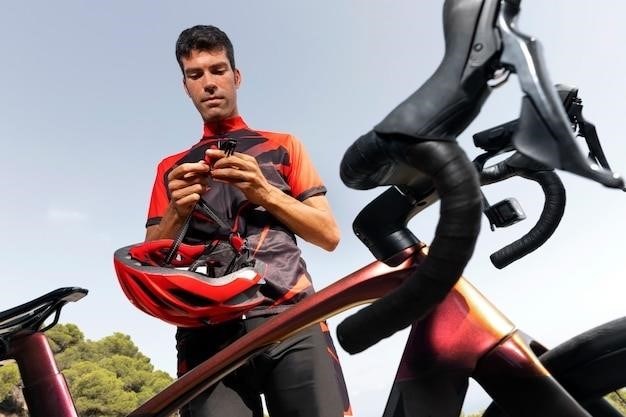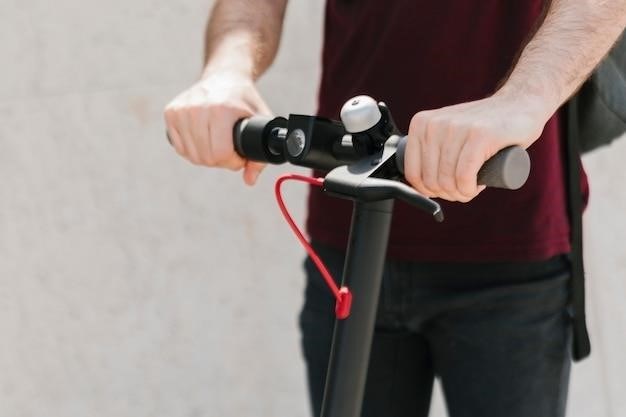Manual Trainer BMX⁚ Mastering the Manual
A manual trainer is a specialized piece of equipment designed to help BMX riders practice and improve their manual skills. It provides a stable and controlled environment for riders to work on their balance and control, allowing them to develop the muscle memory and coordination needed to perform manuals on their bikes.
What is a Manual Trainer?
A manual trainer is a specialized piece of equipment designed to help BMX riders practice and improve their manual skills. It essentially simulates the feeling of riding a BMX bike on just the rear wheel, allowing riders to develop the balance and control necessary for performing manuals. Manual trainers typically consist of a sturdy base with a ramp or platform that supports the rear wheel of the bike, while the front wheel is left free to move. This setup allows riders to practice lifting the front wheel off the ground and maintaining their balance, without the risk of falling or crashing.
Manual trainers come in various designs, from simple DIY models made from scrap wood to more elaborate commercial trainers with adjustable features. Some trainers are specifically designed for practicing nose manuals, while others cater to rear manuals. Regardless of the design, the core function remains the same⁚ to provide a controlled environment for riders to hone their balance and control skills, leading to a smoother and more confident manual on their actual BMX bike.
Benefits of Using a Manual Trainer
Manual trainers offer numerous benefits for BMX riders looking to master the manual⁚
- Improved Balance and Control⁚ By isolating the balance point and providing a stable environment, manual trainers allow riders to practice maintaining equilibrium on just the rear wheel. This translates to better balance and control on the actual BMX bike, leading to smoother and longer manuals.
- Muscle Memory Development⁚ Repeated practice on the trainer helps develop muscle memory for the specific movements required for manuals. This makes it easier to perform manuals consistently and confidently on the bike.
- Reduced Risk of Injury⁚ Practicing manuals on a trainer eliminates the risk of falling or crashing, allowing riders to focus on technique without fear of injury. This is especially beneficial for beginners or those returning to BMX after a break.
- Confidence Building⁚ Mastering the manual on a trainer builds confidence and encourages riders to progress to more advanced tricks.
In essence, manual trainers provide a safe and effective platform for riders to refine their balance, control, and technique, paving the way for smoother and more impressive manuals on their actual BMX bikes.
Types of Manual Trainers
Manual trainers come in two main categories⁚ DIY and commercial. Each offers unique advantages and caters to different needs⁚
DIY Manual Trainers
DIY manual trainers are often constructed from readily available materials like wood, PVC pipes, or scrap metal. They provide a budget-friendly option and allow riders to customize the trainer to their specific needs. Popular DIY designs feature a simple platform with a ramp or incline for the rear wheel, allowing riders to practice balancing and transitioning into and out of manuals.
Commercial Manual Trainers
Commercial manual trainers are professionally designed and manufactured, offering a more durable and refined experience. They typically feature adjustable settings for height and angle, providing greater customization options. Some commercial models also include additional features like built-in ramps, safety straps, or even a stand for holding the bike upright when not in use.
Ultimately, the choice between a DIY or commercial trainer depends on personal preference, budget, and desired features.
DIY Manual Trainers
Building your own manual trainer is a rewarding and cost-effective way to hone your skills. It allows you to customize the design to your specific needs and preferences. Many DIY manual trainers use readily available materials like wood, PVC pipes, or even scrap metal. A common design involves a simple platform with a ramp or incline for the rear wheel.
The ramp allows you to practice balancing and transitioning into and out of manuals. You can adjust the angle of the ramp to increase or decrease the challenge. You can also add features like a strap to secure the front wheel, ensuring stability during your practice sessions.
While DIY trainers may require some effort and construction skills, they offer a budget-friendly and personalized approach to mastering the manual. Numerous online resources provide detailed plans and instructions for building your own manual trainer, allowing you to create a custom setup that meets your individual needs.
Commercial Manual Trainers
For riders who prefer a pre-made, ready-to-use option, commercial manual trainers provide a convenient and often more durable solution. These trainers are typically constructed from sturdy materials like metal or high-quality wood, offering a robust platform for consistent practice.
Commercial manual trainers often come equipped with adjustable features, allowing you to customize the angle of the ramp, the height of the platform, or even the distance between the front and rear wheel supports. Some models may also incorporate additional features like a built-in wheel chock or a strap system for added stability.
While commercial manual trainers tend to be more expensive than DIY options, they offer the benefit of professional craftsmanship, pre-engineered designs, and often come with a warranty. They are a great choice for riders looking for a high-quality, reliable tool to help them master the manual.
How to Choose a Manual Trainer
Choosing the right manual trainer depends on your individual needs and preferences. Consider the following factors⁚
DIY vs; Commercial⁚ DIY trainers offer a cost-effective option, but may require more effort and time to build. Commercial trainers provide a more durable and often more feature-rich solution, but come at a higher price.
Size and Portability⁚ If space is a concern, opt for a compact trainer that can be easily stored or transported. If you plan to use the trainer frequently, a larger, more stable model might be preferable.
Adjustability⁚ Look for a trainer that allows you to adjust the angle of the ramp, the height of the platform, or the distance between the wheel supports. This will enable you to gradually increase the difficulty of your practice sessions.
Features⁚ Some trainers come with additional features like built-in wheel chocks, straps for added stability, or even storage compartments for tools and accessories. Consider what features are most important to you.
How to Use a Manual Trainer
Using a manual trainer is a straightforward process, but it requires patience and practice. Here’s a step-by-step guide⁚
Set Up⁚ Assemble your manual trainer according to the manufacturer’s instructions. Ensure that it is stable and securely positioned on a level surface.
Adjust the Angle⁚ Start with a gentle ramp angle and gradually increase it as you gain confidence. This allows you to gradually increase the difficulty and challenge your balance.
Practice Riding Onto the Trainer⁚ Begin by rolling onto the platform with your feet on the pedals. Focus on maintaining a balanced and upright position as you transition from the ground to the trainer.
Find Your Balance Point⁚ Once you’re comfortable on the platform, experiment with shifting your weight forward and backward to find the point where the bike balances perfectly. This is known as the “sweet spot.”
Practice Manuals⁚ Once you’ve found your balance point, start practicing your manuals. Focus on maintaining a smooth and controlled motion as you lift the front wheel off the ground.
Tips for Practicing Manuals
Mastering manuals takes time and dedication. Here are some tips to enhance your practice sessions⁚
Start Slowly⁚ Begin with short manuals and gradually increase the duration as you improve. Don’t rush the process.
Focus on Balance⁚ Pay close attention to your body position and weight distribution. Maintaining a balanced stance is crucial for achieving smooth manuals.
Use Your Core⁚ Engage your core muscles to help maintain stability. A strong core provides the necessary support for controlling the bike.
Practice Consistency⁚ Regular practice is key to developing muscle memory. Aim for consistent sessions to ingrain the proper techniques.
Visualize Success⁚ Before starting, visualize yourself performing a perfect manual. Mental rehearsal can help improve your focus and confidence.
Don’t Get Discouraged⁚ Manuals can be challenging, so don’t get discouraged if you don’t master them immediately. Keep practicing and celebrate your progress.
Common Mistakes to Avoid
Learning to manual on a BMX bike is a process, and along the way, you might encounter some common pitfalls. Being aware of these mistakes can help you avoid them and accelerate your progress⁚
Leaning Too Far Back⁚ This is a common mistake that can lead to the bike tipping forward. Maintain a balanced stance with your weight slightly forward.
Over-steering⁚ Excessive steering can throw off your balance and make it difficult to maintain control. Keep your steering movements minimal and precise.
Not Engaging Your Core⁚ A weak core will make it harder to stabilize the bike. Actively engage your core muscles to provide the necessary support.
Rushing the Process⁚ Don’t try to learn too much too quickly. Start with the basics and gradually build your skills. Patience is key.
Giving Up Too Easily⁚ Manuals require practice and perseverance. Don’t get discouraged if you don’t master them immediately. Keep trying and celebrate your progress.
Safety Precautions
While manual trainers offer a controlled environment for practicing, safety should always be a priority. Here are some precautions to take⁚
Proper Gear⁚ Always wear a helmet, elbow pads, and knee pads. Consider wearing gloves for added protection.
Secure Setup⁚ Ensure the manual trainer is securely assembled and stable on a flat surface. Avoid using the trainer on uneven or slippery terrain.

Clear Surroundings⁚ Clear the area around the trainer of any obstacles or hazards that could cause a fall.
Start Slow⁚ Begin with short sessions and gradually increase the time as you gain confidence. Avoid overexertion, and take breaks when needed.
Listen to Your Body⁚ If you feel any pain or discomfort, stop immediately and rest. Don’t push yourself beyond your limits.
Mastering the manual is a rewarding skill that can elevate your BMX riding experience. Manual trainers provide a valuable tool for developing the balance, control, and muscle memory necessary to confidently execute manuals. Whether you choose to build your own trainer or invest in a commercial model, consistent practice and dedication are key to achieving success. Remember to prioritize safety, start with small steps, and celebrate your progress along the way. As you refine your skills, you’ll find yourself tackling more challenging tricks and maneuvers with greater ease and confidence.
Where to Buy a Manual Trainer
If you’re ready to invest in a manual trainer to take your BMX skills to the next level, there are several options available. Online retailers like Amazon and eBay often offer a wide selection of pre-built trainers, as well as DIY kits and components. Specialized BMX shops are another great resource, as they can provide expert advice and guidance on choosing the right trainer for your needs. Local bike shops may also carry manual trainers, or be able to order them for you. Consider factors like price, portability, durability, and features when making your purchase. Remember, a quality manual trainer can be a valuable investment in your BMX journey, helping you unlock new tricks and elevate your riding experience.
Manual Trainer Resources
There are plenty of resources available online to help you learn more about manual trainers and how to use them effectively. YouTube is a great starting point, with many videos showcasing DIY manual trainer builds, tutorials on how to use a manual trainer, and tips for practicing manuals. BMX forums like Reddit’s r/bmx are active communities where riders share their experiences, tips, and advice on using manual trainers. You can also find detailed articles and blog posts from BMX experts and enthusiasts that cover various aspects of manual training, from choosing the right trainer to mastering the technique. Don’t hesitate to tap into these resources to enhance your understanding and progress on your manual journey.
